Birds of Kasbah Ameridhil
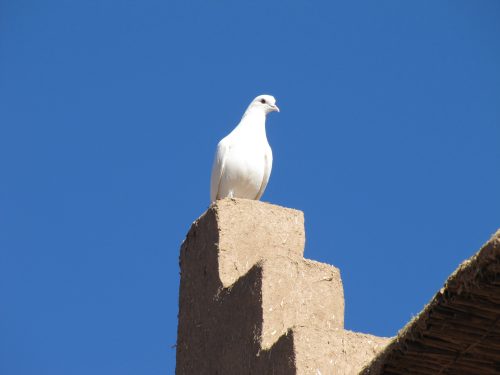
Rock Dove
On our tour of Morocco, I took every opportunity to do some birding.
It proved to be more difficult than I thought. Because we were with a mini-bus tour group, the opportunities to stop and watch – and photograph – the local birds were somewhat limited. I was constantly distracted by looking at the sights, as well as taking photos of the buildings and scenery, as well as listening to our guide and keeping up with the tour group.
In many situations, I could not take the time to get good photos which would have helped with identification later. During our visit to the beautiful Kasbah Ameridhil, I was able to take several photos, and these are featured today. Sadly, they are of very common species, birds I can see almost anywhere here at home in Australia. Above and below, I included photos of two differently coloured Rock Doves. The pure white one above is particularly nice; one does not normally get pure white birds in this varied species. It is more normal to get the plain grey and black colours as in the one below.
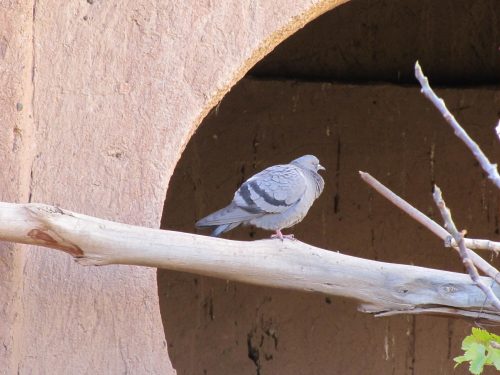
Rock Dove
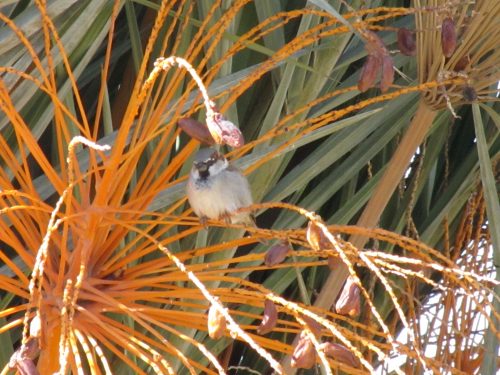
House Sparrow (male)
Another species present in large numbers was the House Sparrow, one of which is shown above. This species appears to be very common in many parts of the world.
The last photo (below) is of a White Stork. I saw plenty of this species throughout our tour of Morocco. This pair – I am assuming that they are a pair – have constructed quite a massive nest on a nearby building. The birds are over a metre tall, so this nest would have to be four or five metres tall. They obviously do not get very strong winds in this area – or those birds are very good at constructing a solid nest.
You can read about Australian birds I have photographed on my other site Trevor’s Birding.
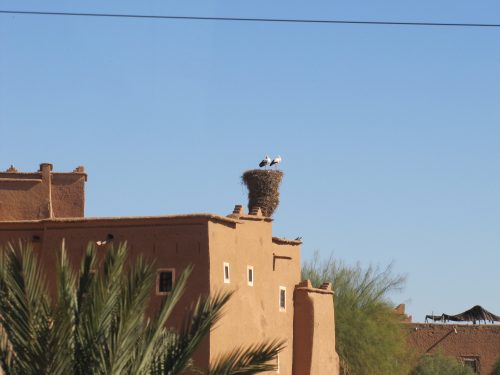
White Storks
Kasbah Ameridhil in Skoura, Morocco
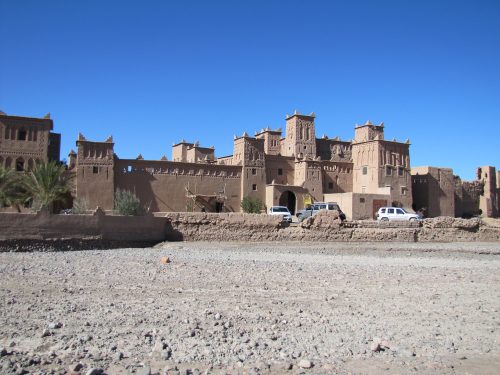
Kasbah Ameridhil, Skoura, Morocco
On our tour of Morocco, we stopped for a short while at the amazing Kasbah Ameridhil near Skoura. We had a guided tour of the buildings and saw some very interesting relics of a by-gone era (see photos below). This particular kasbah has been used as the backdrop for a number of films, including Ali Baba and the Forty Thieves. This story is often included in the collection known as A Thousand and One Arabian Nights.
This Kasbah is the stuff of legends. Built in the 17th century, it not hard to let one’s imagination soar, with plots and intrigues, murders and sword fights as well as a whole nightmare of treacherous happenings. For the more romantically inclined, it is not hard to imagine secret trysts of lovers and murderous paybacks by those jilted in the process.
It is now a living museum of life in a kasbah. We saw displays of tools and instruments used down through the centuries, as well as hand-carved door locks, an olive-oil press, still-functioning bread ovens, and stalls where animals were once kept.
This Kasbah has pride of place in Moroccan history, and it is no surprise that it is featured on the 50 dirham banknote of Morocco.
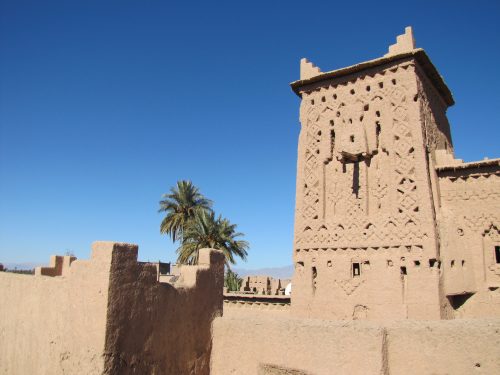
Kasbah Ameridhil, Skoura, Morocco
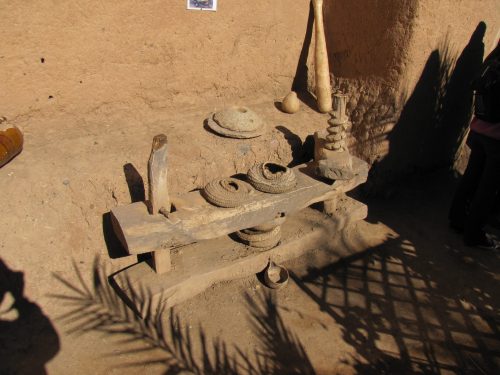
Kasbah Ameridhil, Skoura, Morocco
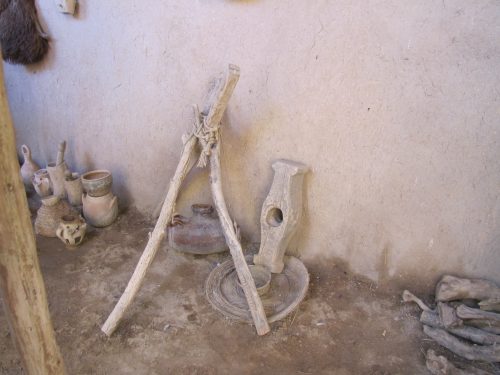
Kasbah Ameridhil, Skoura, Morocco
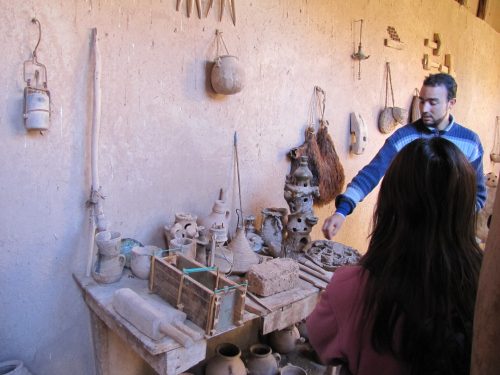
Kasbah Ameridhil, Skoura, Morocco
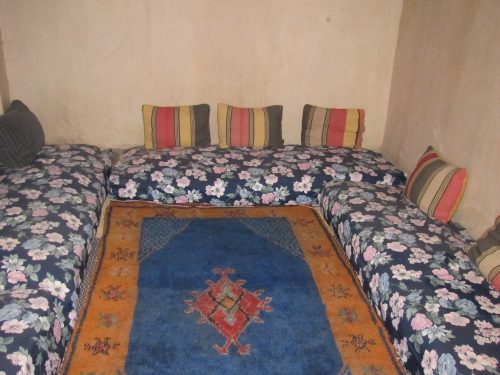
Kasbah Ameridhil, Skoura, Morocco
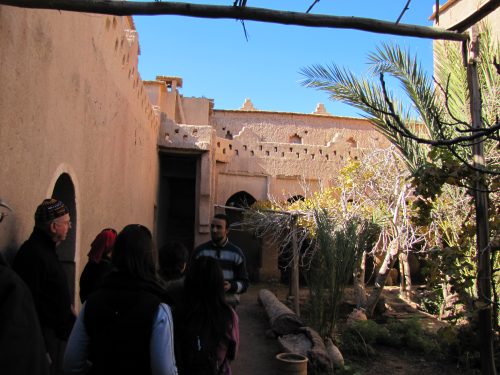
Kasbah Ameridhil, Skoura, Morocco
A wonderful Berber omelette
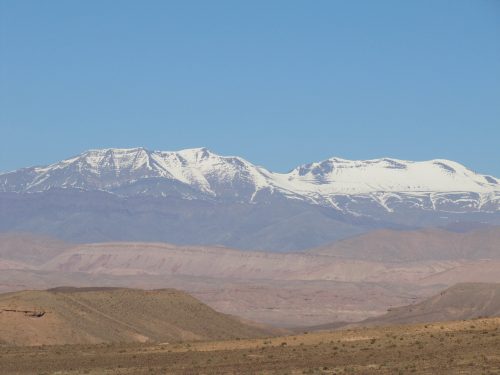
Atlas Mountains, Morocco
On our last morning in the Dades Valley on our tour of Morocco, we had a wonderful treat for breakfast. Our tour guide was up early, scouring nearby farms for enough eggs to make us a genuine Berber omelette. Genuine or not, it was delicious, made even more palatable by the alleged effort made to procure the ingredients. I am not a great fan of omelettes at the best of times, but this treat was far superior to any other omelette I had ever tasted. It was followed by a delicious pancake.
While on our trip through Morocco I discovered that I had a palate that was far more adventurous than I thought. I was actually looking forward to experiencing the many tastes of Morocco as well as the scenery, the people and of course, the architecture. I was not disappointed on this trip – and we still had Spain ahead of us on this trip.
After our long walk along the Dades Valley the day before, we were pleased that the next day was mainly occupied in transit while sitting on the bus. When we left the Dades valley we drove along the Roses Valley, so-called due to the plentiful rose plants surrounding many of the fields. Locally, rose water and perfumes are made and sold at many outlets. At one of our stops, even my wife succumbed to lure of these local delights.
We travelled the Road of a Thousand Kasbahs towards the town of Skoura. Along the way, we passed through some desolate country which is shown in the photos on today’s post (see below). At certain points, we had distant views of the snow-capped Atlas Mountains, a spectacular range we would traverse later in our tour.
In the desolate areas, there were wide expanses of stony country and from time to time we passed a few hardy nomadic Berbers following their traditional ways. At one point, our guide astounded us by a little piece of Australia on the roadside. Several thousand hectares of the desolate land had been planted with Australian saltbush in the 1990s. This was supposed to provide extra food for the sheep and goats of the local shepherds. The plantations were abandoned after protests from the local people, but there is still some evidence on the plantations (see photos below).
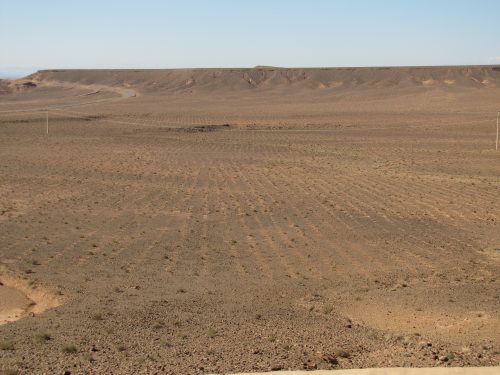
Australian saltbush plantation in Morocco
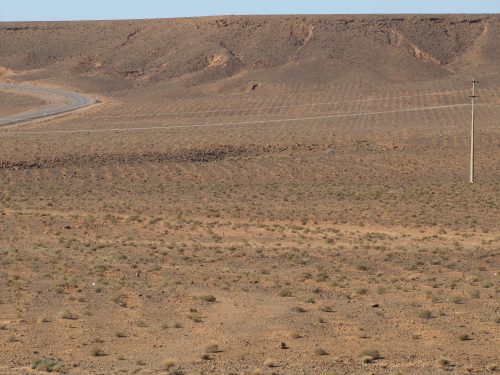
Australian saltbush plantation in Morocco
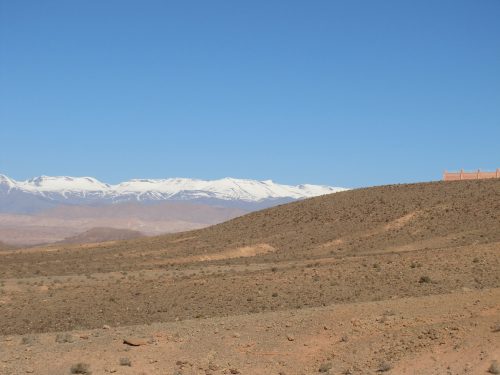
Atlas Mountains, Morocco
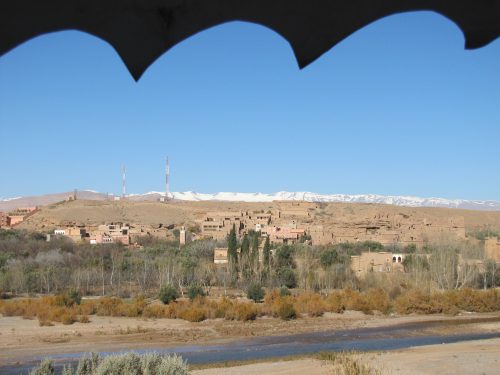
In the distance the Atlas Mountains, Morocco
Architectural contrasts in Morocco
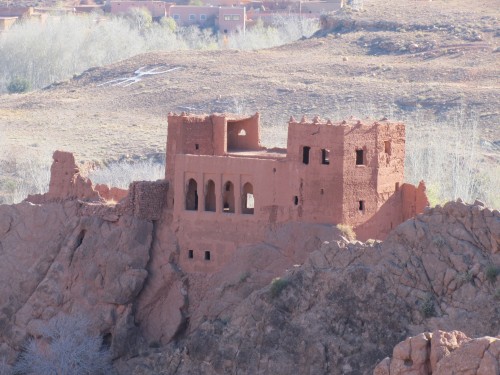
Old kasbah building in the Dades Valley
Over recent weeks, I have been sharing many of my photos taken during a tour of Morocco. You can look back through these posts to read them, or you can use the archives to search for them – the link is above the title of this post.
Kasbahs
Over the two weeks of our tour, we saw many magnificent buildings, especially those featuring mosaic tiles. These really caught our attention and we enjoyed visiting such buildings. Part way through our tour we spent two nights in the Dades Valley, a predominantly Berber region of the country. Here the architecture was quite different, as shown in today’s photos. One part of this area is the is known as the Road of the Thousand Kasbahs on which we travelled on our way to Skoura.
Adobe buildings
One of the architectural features of this region is the adobe buildings of the Berbers, as shown in today’s photos. These old kasbahs are mud structures, either made from mud-bricks or rammed earth. (If this is wrong, could my readers please enlighten me. Our guide was not forthcoming on this matter, and I didn’t ask.)
Many of the old kasbahs are no longer inhabited. A more modern building style in this area is also shown below. It may also be made from mud bricks, but the outer walls have a rendering which makes it look very stylish indeed. I suspect that this modern home may also have been made using local stone which is plentiful in this mountainous region of the Atlas Mountains.
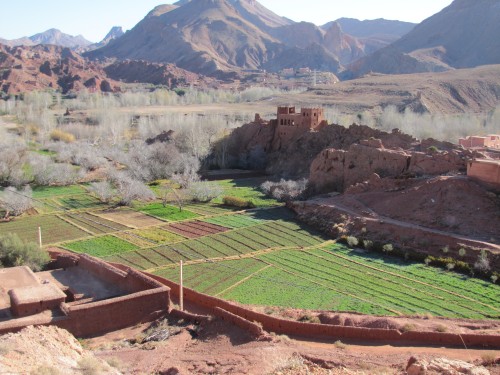
Old buildings in the Dades Valley set in farming country
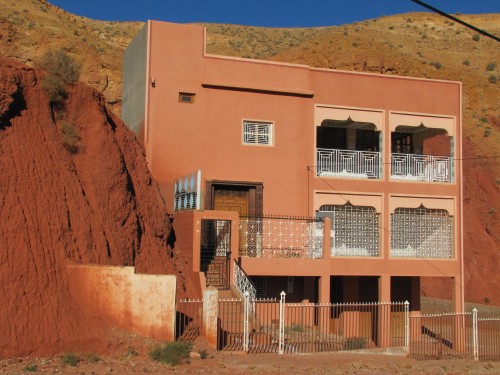
Modern building in the Dades Valley
Dades Valley in Morocco
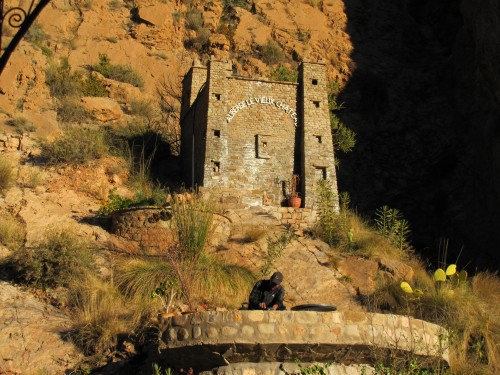
Opposite our hotel in the Dades Valley
Over recent posts, I have been describing our experiences in the Dades Valley of Morocco. During our two-night stay in the Hotel du Vieux Chateau du Dades I never found out what the structure shown in the photo above was meant to be, or why it was there – apart from being advertising for the hotel where we stayed, which was across the road. It was similar to several other buildings nearby, so it could well have been simply an example of the typical local architecture. The builders obviously used the common building material available at this location. Further down the valley, the predominant building material was mud, as seen in the last few photos below.
A great breakfast feast
Our tour guide, Said, promised us a Berber omelette for breakfast. He came good on this promise. On the downside, however, he reported at breakfast time that he had been up very early that morning scouring the neighbourhood for enough fresh eggs to make omelettes for the whole group. I am pleased that he went to the effort because the result was delicious. They were actually cooked in tagines and I can still remember the taste sensation. Mine was followed by indulging in a delicious pancake.
We travel on
After breakfast, we packed the bus and headed off down the Dades Valley road towards the Road of the Thousand Kasbahs and the Rose Valley. Along this stretch of road, I took the photos shown today mostly from the bus window though we did stop several times at lookouts along the way.
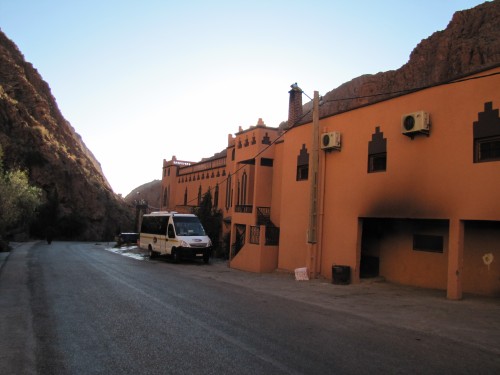
Our hotel in the Dades Valley. Our tour bus is also in the photo.
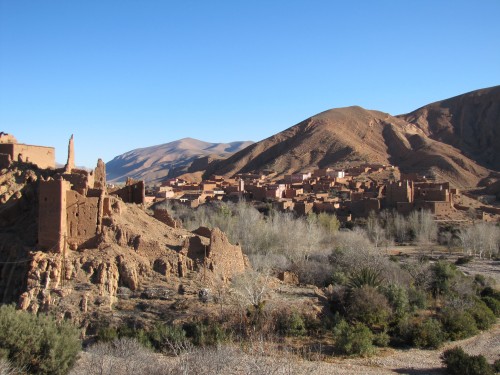
A scene along the Dades Valley road.
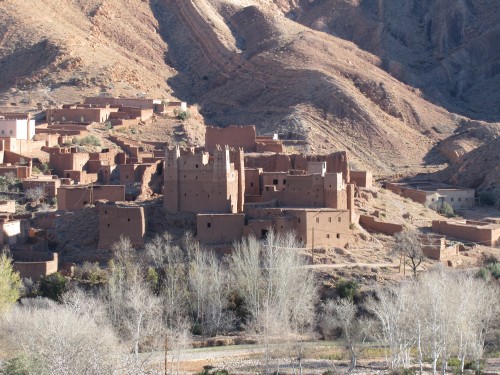
A scene along the Dades Valley road.